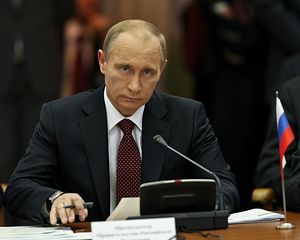President Putin feels he knows what is best for Ukraine. He feels very comfortable defining its national interests, which in his view are to be aligned with Russia. This was the picture he conveyed to students at St. Petersburg’s Mining University on 25 January. He said that volunteer units fighting against the rebels were a “foreign legion of NATO” who were not acting in Ukraine’s national interest but rather were fighting to contain Russia geopolitically. He described the fighting as a “civil war”, a fact (he said) that many people now recognize. Two days earlier, he told the National Security Council that “we are seeing a sharp deterioration in the situation”. He reported that Ukraine had ignored a Russian proposal to withdraw heavy weapons from the line of control and had responded by ordering intense operations across the entire front line of the contest areas and call up of young men in the areas affected by the fighting. (In response NATO accused Russia of supporting an escalation of rebel operations.)
Russia’s official news agency, Novosti, echoed the Putin line on its website within days, talking of a sharp turn in the situation as the lead for its page on “The Situation in Donbas”, a shorthand term for the People’s Republics of Donetsk and Lugansk. One of the reports it carried was that 650,000 people were without water as a result of the fighting. It also reported that Ukrainian forces had fired on a hospital. Russia continues to make the legal case for more radical intervention by it in Ukraine under the guise of a “humanitarian intervention”.
Novosti did not report the news that on 25 January, the rebels had announced a new front and openly attacked the city of Mariupol, the main port for the Donetsk region. Mariupol, mainly Russian speaking, is a strategic target for an independent Donetsk republic, but it is also on the coast between Crimea and Russia. On 26 January, Novosti carried a map, showing Mariupol as being under Ukrainian control and not on the rebel side of the line of control. The map also showed the artillery positions of the two sides.
But this line of control is only temporary in the eyes of President Putin. Over the medium term (3-5 years), Russia almost certainly will seek to establish a land bridge under its control between Crimea and the Russia/Ukraine border on the east of Donetsk province. There is a need to focus on Putin’s strategic goals in Ukraine rather than the detail of ephemeral proposals under this or that deal intended by him as a diplomatic smokescreen. One of Russia’s independent researchers, Dmitry Trenin, reported in 2011 that at the time of the Orange Revolution and Ukrainian interest in membership of NATO (around 2005 and following), “some not entirely academic quarters in Moscow played with the idea of a major geopolitical redesign of the northern Black Sea area, under which southern Ukraine, from the Crimea to Odessa, would secede from Kiev and form a Moscow-friendly buffer state.” In April 2014, Putin said that the southern and eastern provinces of Ukraine used to be Russian (and were called “Novorossiya” or “New Russia”). He said that they were unwisely transferred by the communists to Kiev’s control in 1920, and that a new sovereignty solution for these regions had to be worked out.
Another hint of the grander strategic plan in play came with the report from Novosti that the rebel Donetsk authorities will hold a summit of “unrecognized governments” in February or March this year. While territories such as the Basque region of Spain, Flanders in Belgium, Venice in Italy, and even Texas in the USA were mentioned, the one invitee to watch will be Transdnistr, a breakaway region of Moldova aligned with Russia. This territory is on the western border of Ukraine’s Odessa province and would be the last building block of a new political order for the former Novorossiya, stretching all the way to Odessa.
Novosti has dropped its previous referencing of “Novorossiya” it was using in April last year in favor of the more neutral Donbas, and Putin has made fairly plain that the rebel regions will not become part of Russia. But we need to continually bear in mind that this is still all part of the larger geopolitical canvas. In the same way that Russian agencies now appear to be working closely with rightist or extreme political parties in Europe, such as the National Front in France, the holding of a summit of unrecognized states in Donetsk will be a further escalation of the geopolitical contest with Europe, which Putin launched when he revived Russian special forces (“spetsnaz”) within the armed forces in June 2013. Somewhat unsurprisingly, he put them in play within six months to destabilize Ukraine. The Russian move was its response to Ukraine’s clear decision in 2012 for alignment with Europe rather than Russia and followed more than eight years of warning by Russia of unspecified negative consequences of an abandonment of what it saw as Ukrainian non-alignment.

































